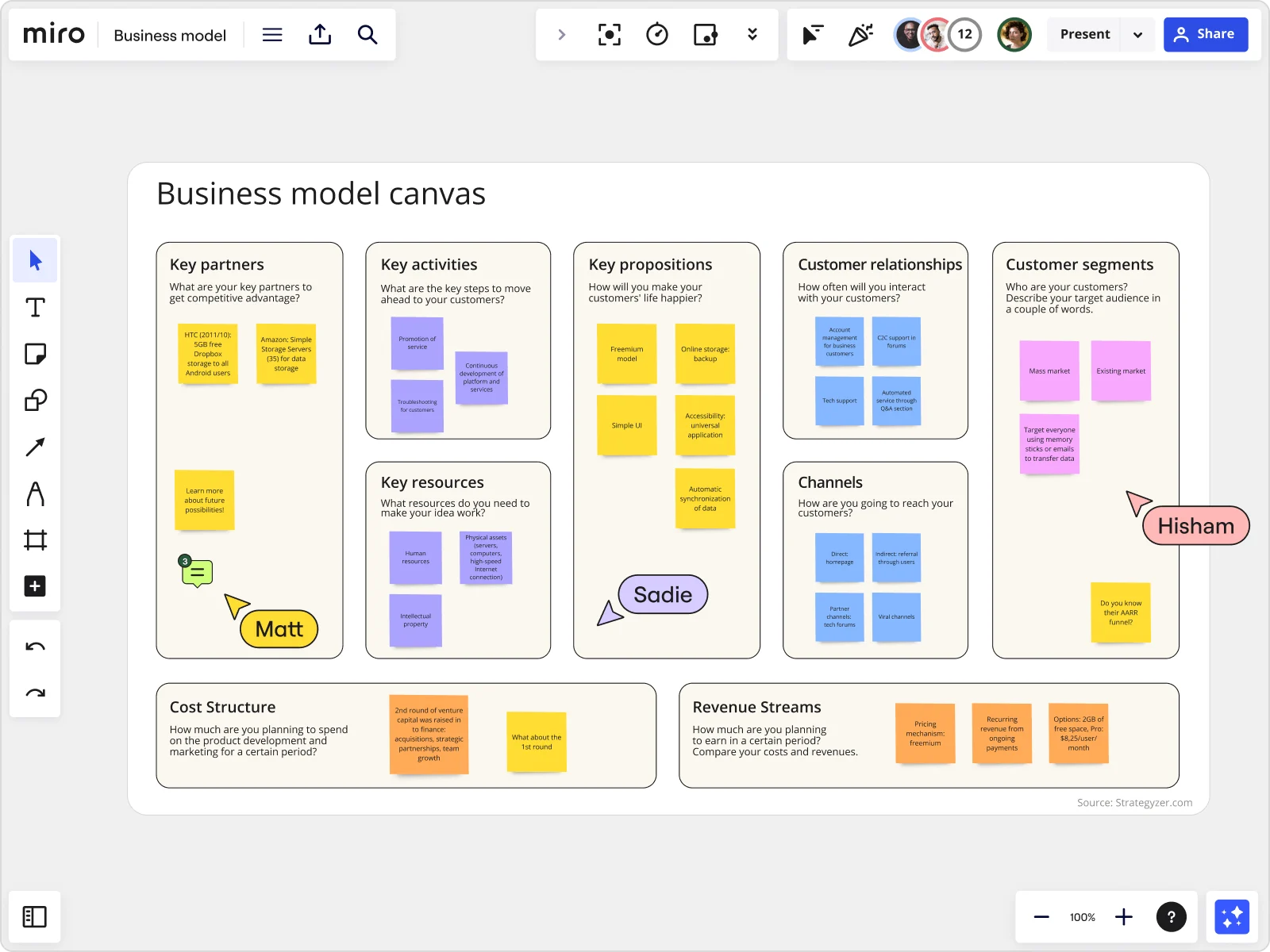
10 Business plan template examples to bring your vision to life

Summary
In this guide, you will learn:
How to use business plan templates in Miro for planning.
Components of a traditional business plan template.
How the Business Model Canvas template maps business elements.
Ways to organize strategy using the Business Plan Mind Map template.
How to develop detailed sections like product descriptions and financial budgets.
Tips for collaborating and customizing templates in Miro.
Try Miro now
Join thousands of teams using Miro to do their best work yet.
If you're reading this, you’re probably sitting at the crossroads of a new venture. Whether you’re about to start a fresh business or you’re planning to scale your current one, you know that a business plan is a crucial first step. But let’s be honest—building a business plan from scratch can feel overwhelming. Luckily, you don’t need to start with a blank page. With the right business plan templates, you can outline your vision, streamline your thinking, and put all those ideas into action.
In this article, we’ll explore some of the best business plan templates available and show you how these tools can help you get where you want to go. And if you’re looking for a collaborative way to brainstorm and strategize with your team, tools like Miro’s innovation workspace can make the process smoother.
Business plan explained
What is a business plan?
At its core, a business plan is a detailed roadmap for your company’s future. It outlines where you want to go, how you’ll get there, and what success looks like along the way. Think of it as a comprehensive guide that includes your business goals, strategies, and financial projections. Whether you’re starting a new business or scaling an existing one, having a clear plan helps you stay focused and on track.
A well-thought-out business plan is essential when pitching to investors, securing loans, or simply getting your team on the same page. But beyond that, it’s your North Star—guiding your decisions and helping you adapt as market conditions change.
What are the basic components of a business plan?
While the exact format can vary, most business plans follow a similar structure. Here are the basic components you’ll find in a typical business plan:
Executive Summary: A brief overview of your business, including your mission, vision, and key goals.
Company Description: Information about your company’s background, what you do, and your target audience.
Market Research: Insights into your market, industry trends, and the competitive landscape.
Organization and Management: A look at your organizational structure and leadership team.
Product or Service Line: Detailed information about your products or services and how they meet customer needs.
Marketing and Sales Strategy: How you’ll promote and sell your products or services.
Financial Projections: Forecasts for revenue, profit, and expenses.
Funding Request (if applicable): If you’re seeking investment, this section outlines how much you need and how it will be used.
Why is it important to have a business plan?
A business plan isn’t just a box to check; it’s a foundational tool for your company’s success. Here’s why it’s so important:
Clarity: It forces you to think critically about your goals, strategies, and challenges.
Direction: It provides a clear roadmap for your business, guiding decisions and helping you stay on track.
Attracting investment: Investors and lenders will want to see a solid business plan before they commit any funds.
Benchmarking progress: A business plan sets measurable goals, making it easier to track progress and make adjustments as needed.
Risk management: By identifying potential risks upfront, you can create strategies to mitigate them.
Business plan templates in Miro
Now, let’s get into the good stuff: business plan template examples. When you use a template, you’re saving yourself hours of work and tapping into proven structures that help clarify your ideas. Below, we’ll walk through some of the most effective templates for building out your plan. All of these can be easily found in Miro’s innovation workspace, a tool designed for seamless collaboration, whether you’re working in real-time or asynchronously with your team.
Business plan template
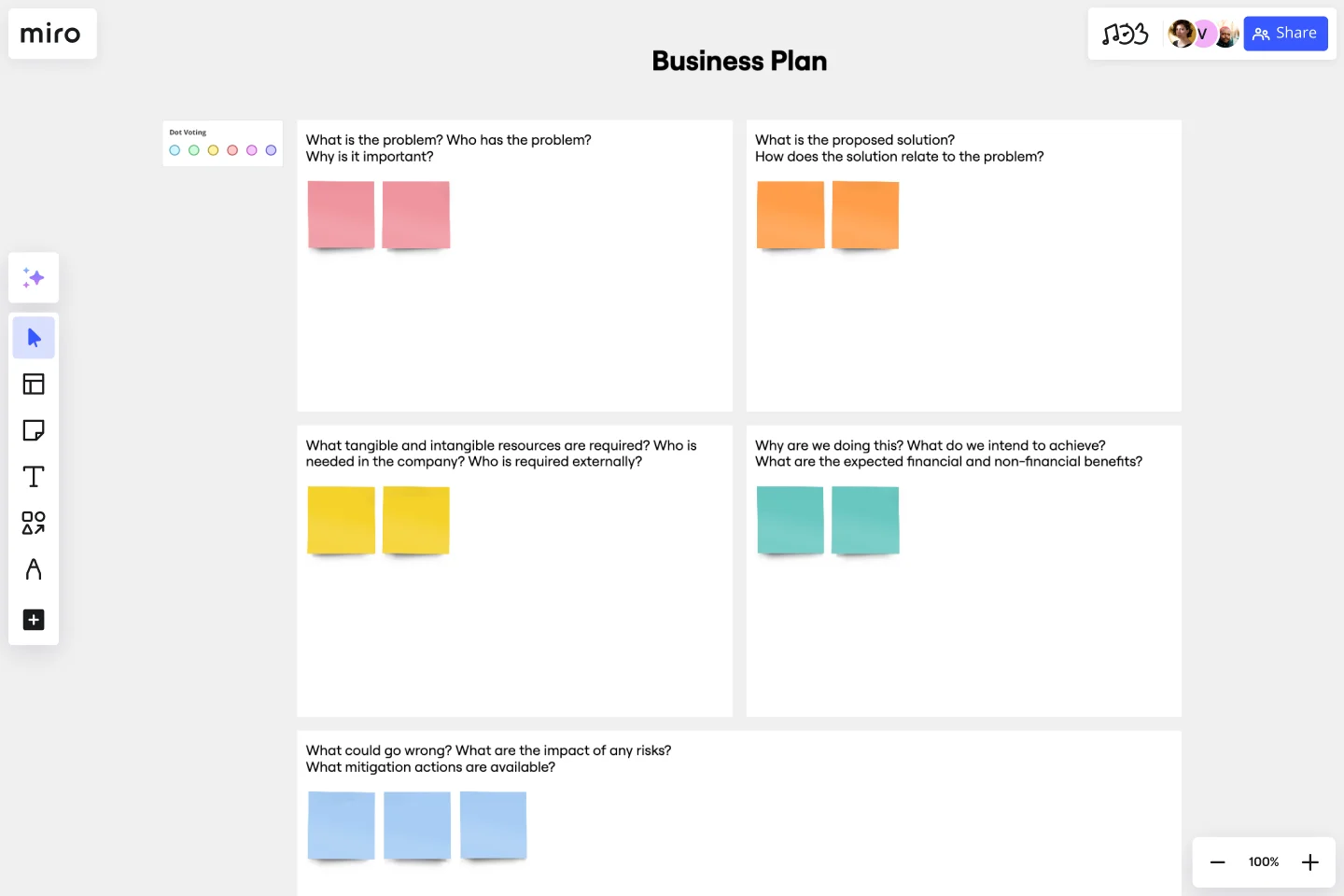
Let’s start with the classic—your traditional business plan template. This template includes everything you need: sections for your executive summary, company description, market research, organizational structure, and financial projections. It’s a tried-and-true format that works for businesses of all sizes.
This template helps you ensure you’ve covered all the bases, from your value proposition to your operational plan. No stone is left unturned, so you can move forward with confidence that your vision is fully fleshed out.
Business Model Canvas template
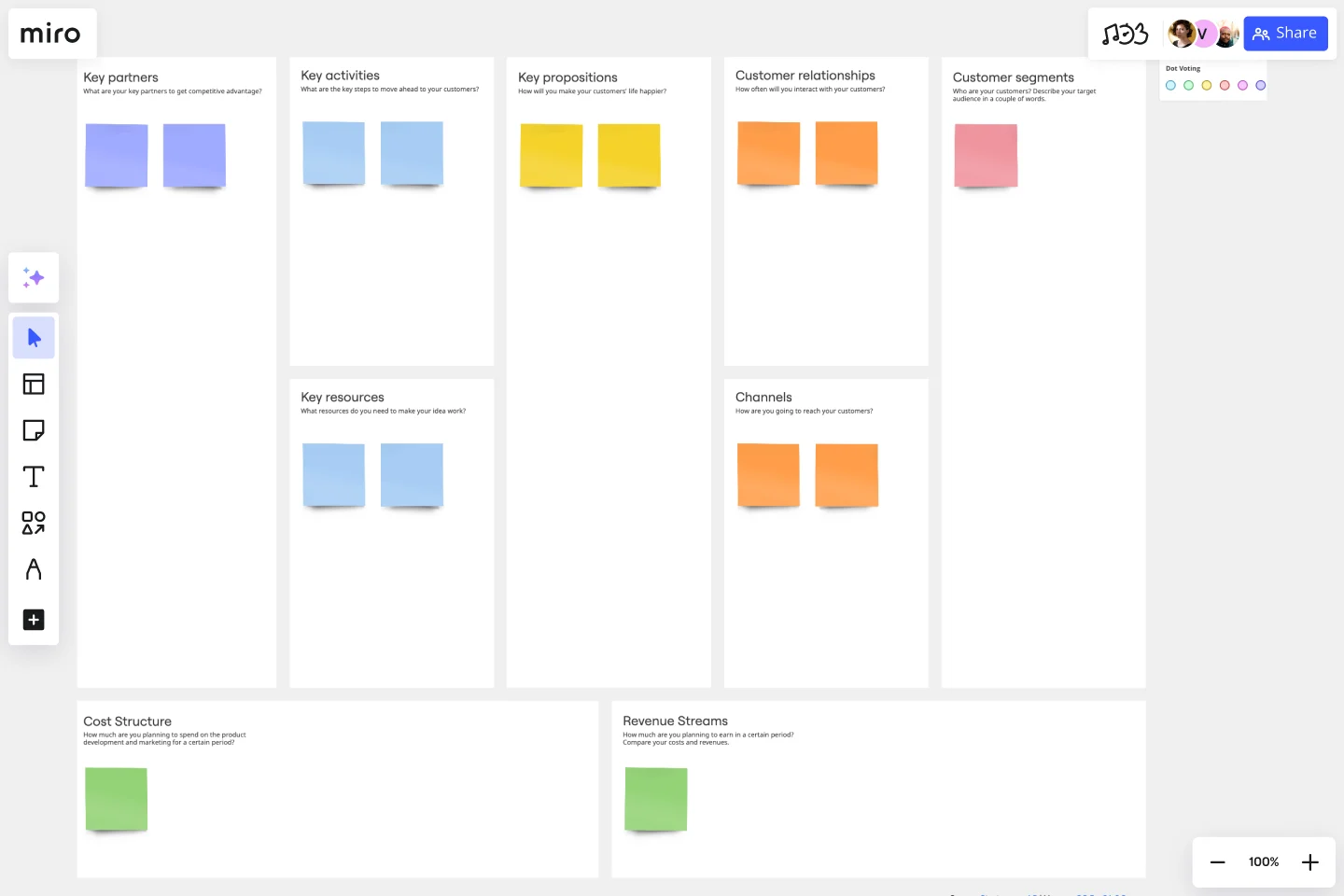
The Business Model Canvas is the blueprint for turning your idea into a profitable business. If you're more of a visual thinker, you’ll love this one. The canvas helps you map out the nine essential building blocks of your business: key partners, key activities, key resources, value propositions, customer relationships, channels, customer segments, cost structure, and revenue streams.
It’s a fast, effective way to see the big picture of your business at a glance. Use this when you want to clarify how all the pieces fit together.
Business pitch template
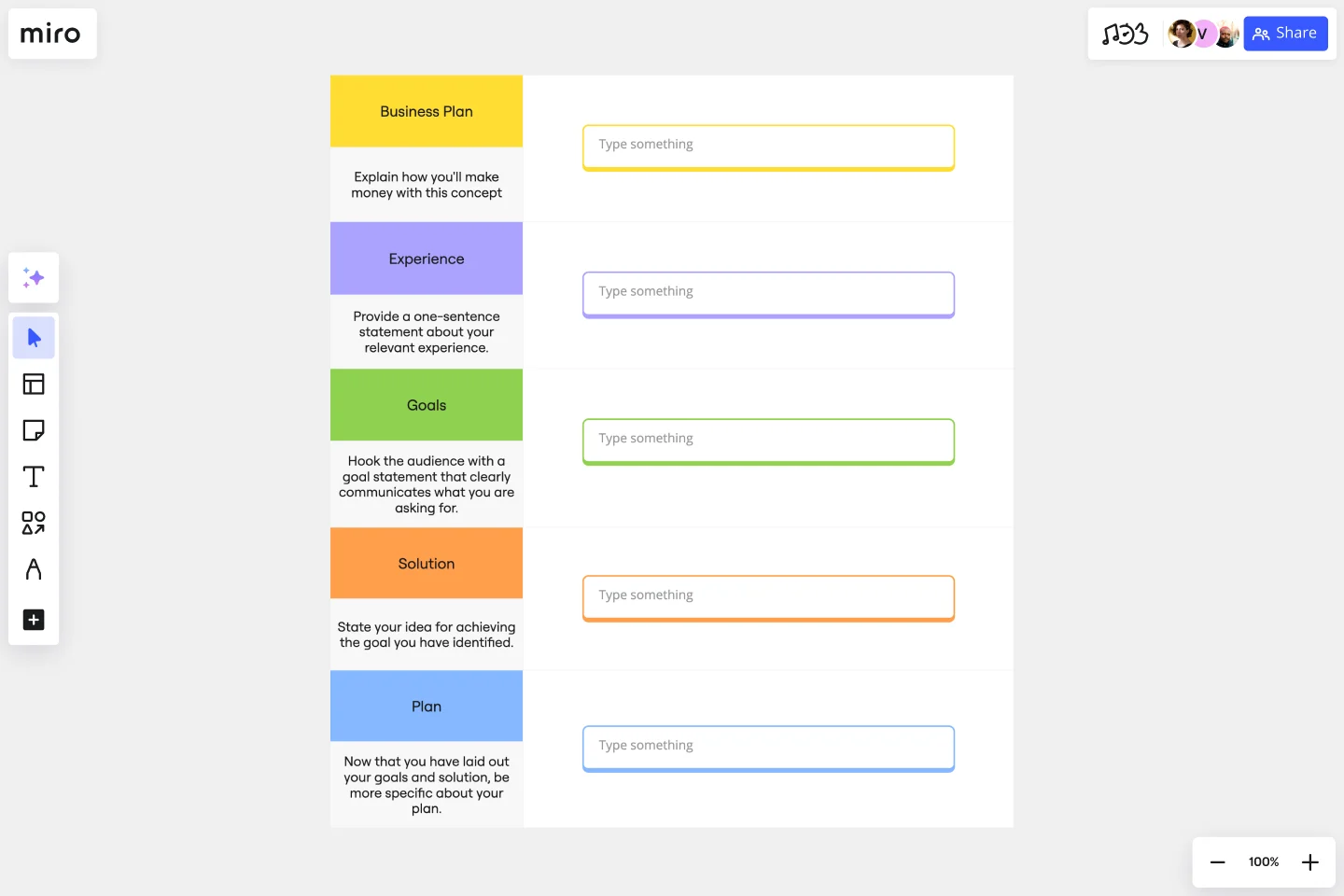
Got an important pitch coming up? The business pitch template is designed to help you communicate your vision succinctly and persuasively. This template focuses on the essentials: your market opportunity, product or service offering, business model, and financials.
It’s perfect for those high-stakes moments when you need to get your point across quickly, whether you’re pitching to investors, stakeholders, or potential partners. In just a few slides, you’ll have everything you need to impress.
Business case template
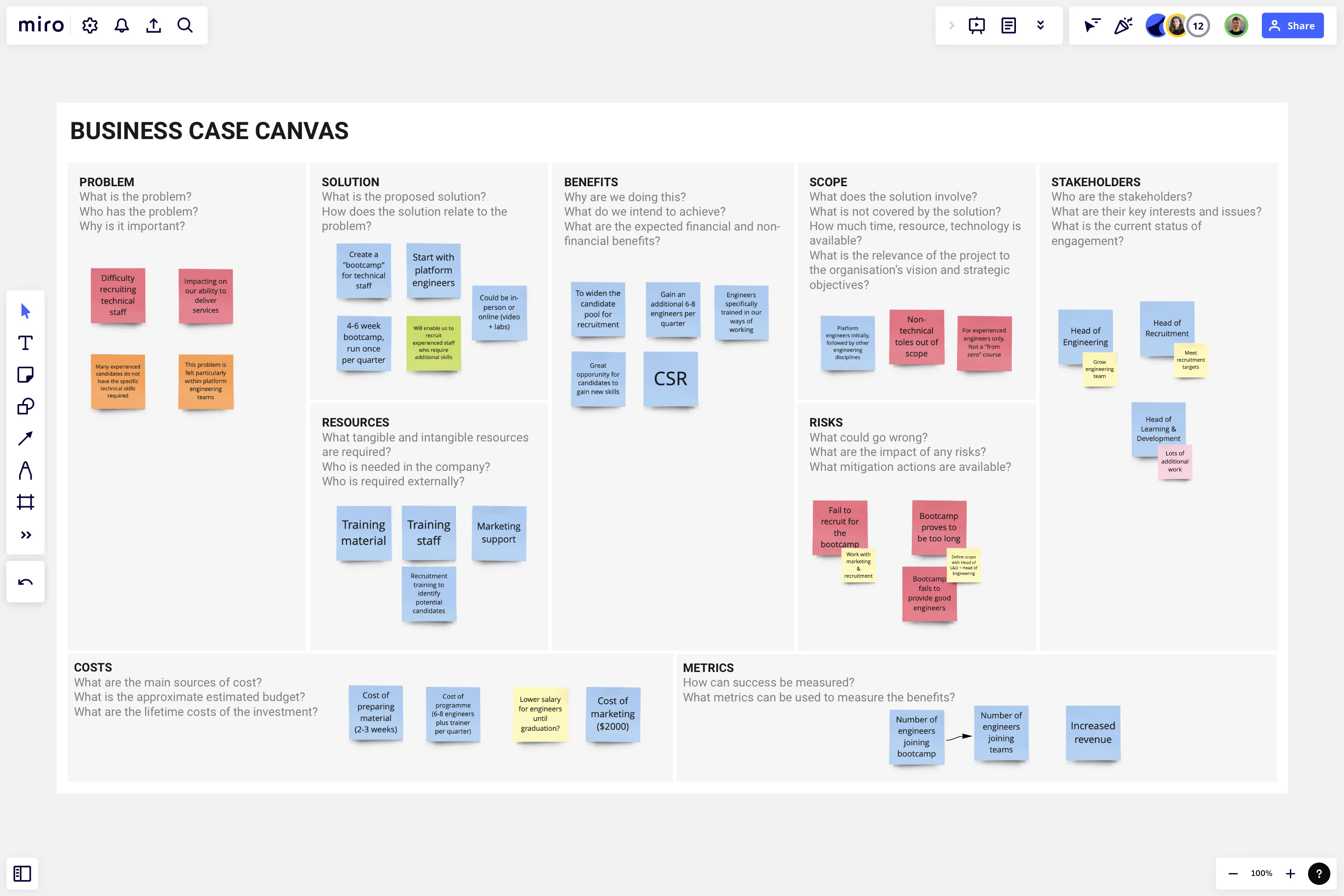
Sometimes, you need more than a pitch—you need to make a solid case. The business case templates helps you create a document that outlines the rationale for a particular project or initiative. It’s not just about selling an idea; it’s about showing why the idea is worth pursuing.
This template includes sections for problem analysis, proposed solutions, cost-benefit analysis, and risk assessment. It’s ideal when you need to get buy-in from decision-makers or prove the value of a new project.
Business plan mind map template
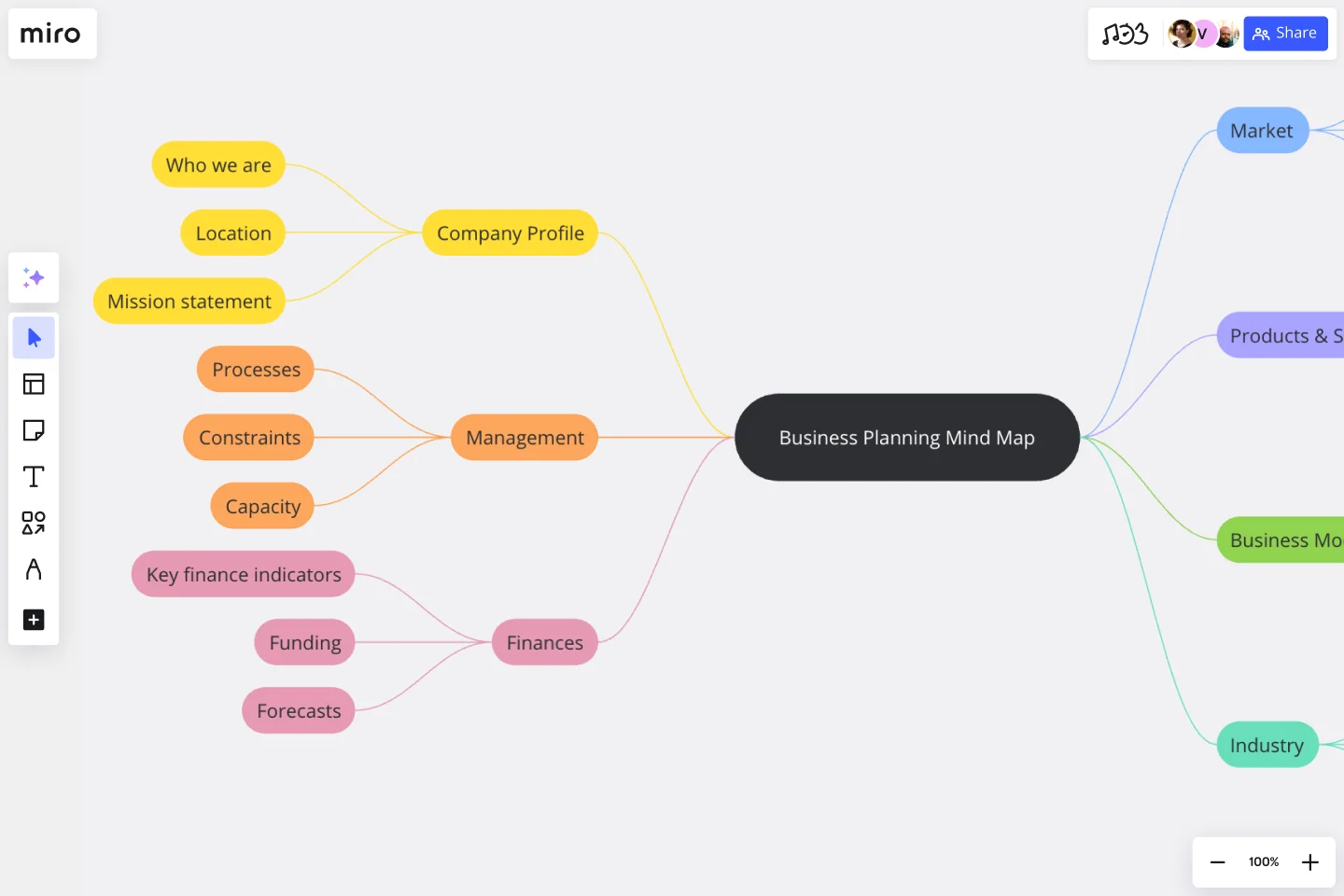
If you’re the kind of person who likes to brainstorm in a non-linear way, the business plan mind map template is for you. Mind mapping lets you connect ideas organically and see how they relate to one another. It’s a great tool for breaking down complex plans into manageable pieces.
Use this template when you’re in the early stages of planning and want to explore all your options. Once you’ve fleshed out your ideas, you can transition into a more structured format.
Goal tracker template for small businesses
Running a small business means wearing a lot of hats, and keeping track of everything can feel like juggling a dozen plates. That’s where the goal tracker template comes in handy. Whether you’re managing daily operations or planning long-term growth, this template will keep you organized and on track.
Other frameworks to help you build your business plan
In addition to traditional business plan templates, several strategic frameworks can help you refine your plan. Let’s take a look at a few available in Miro’s innovation workspace.
Lean Canvas template
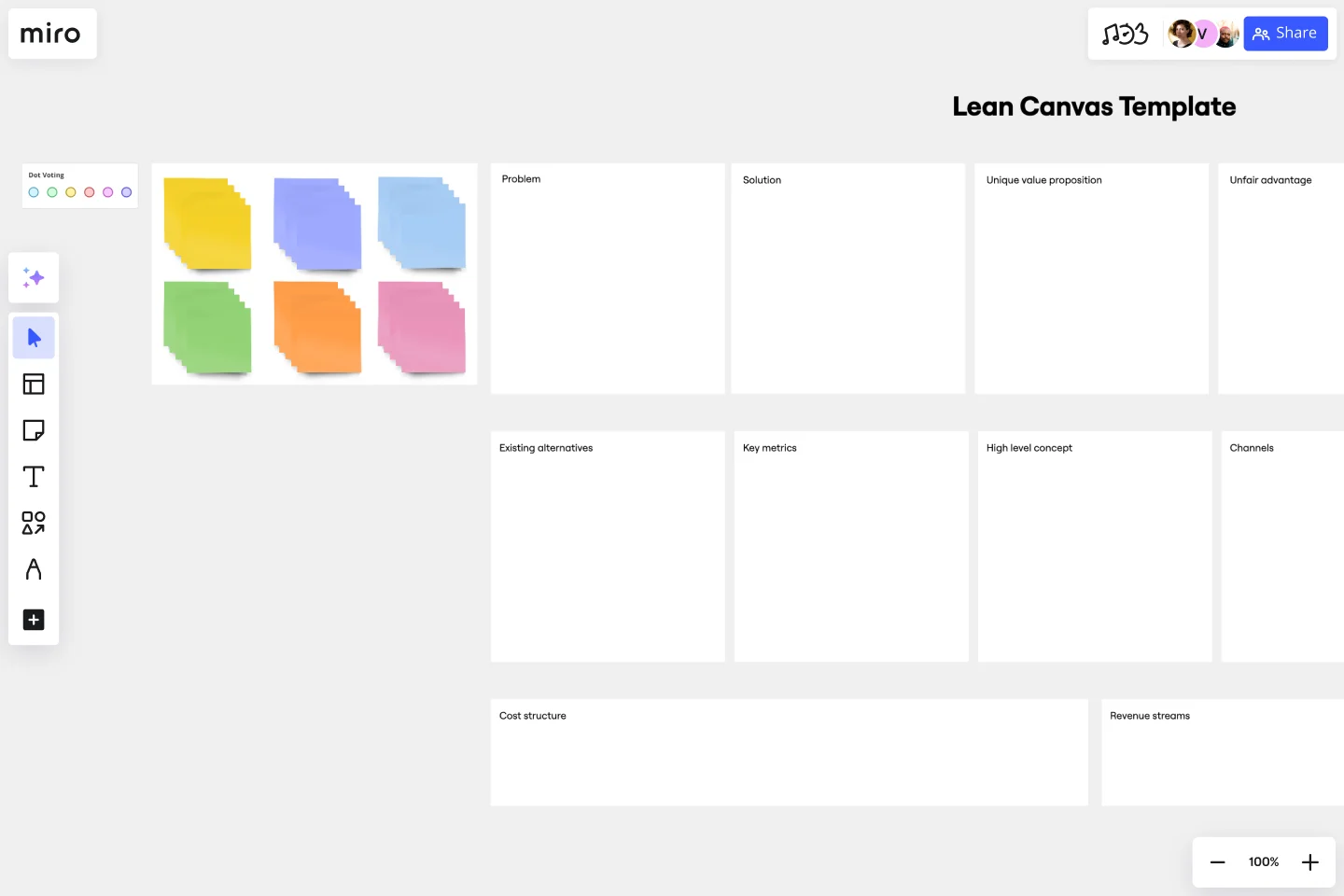
The Lean Canvas is a variation of the Business Model Canvas, designed specifically for startups. It focuses on the key areas most important for new businesses: problem, solution, key metrics, unfair advantage, customer segments, and revenue streams.
It’s a great template to use if you’re launching something new and need to iterate quickly. The Lean Canvas encourages you to test assumptions, pivot when necessary, and stay agile. For structured brainstorming and planning, lean canvas templates provide a practical format to visualize and refine your business strategy.
VRIO analysis template
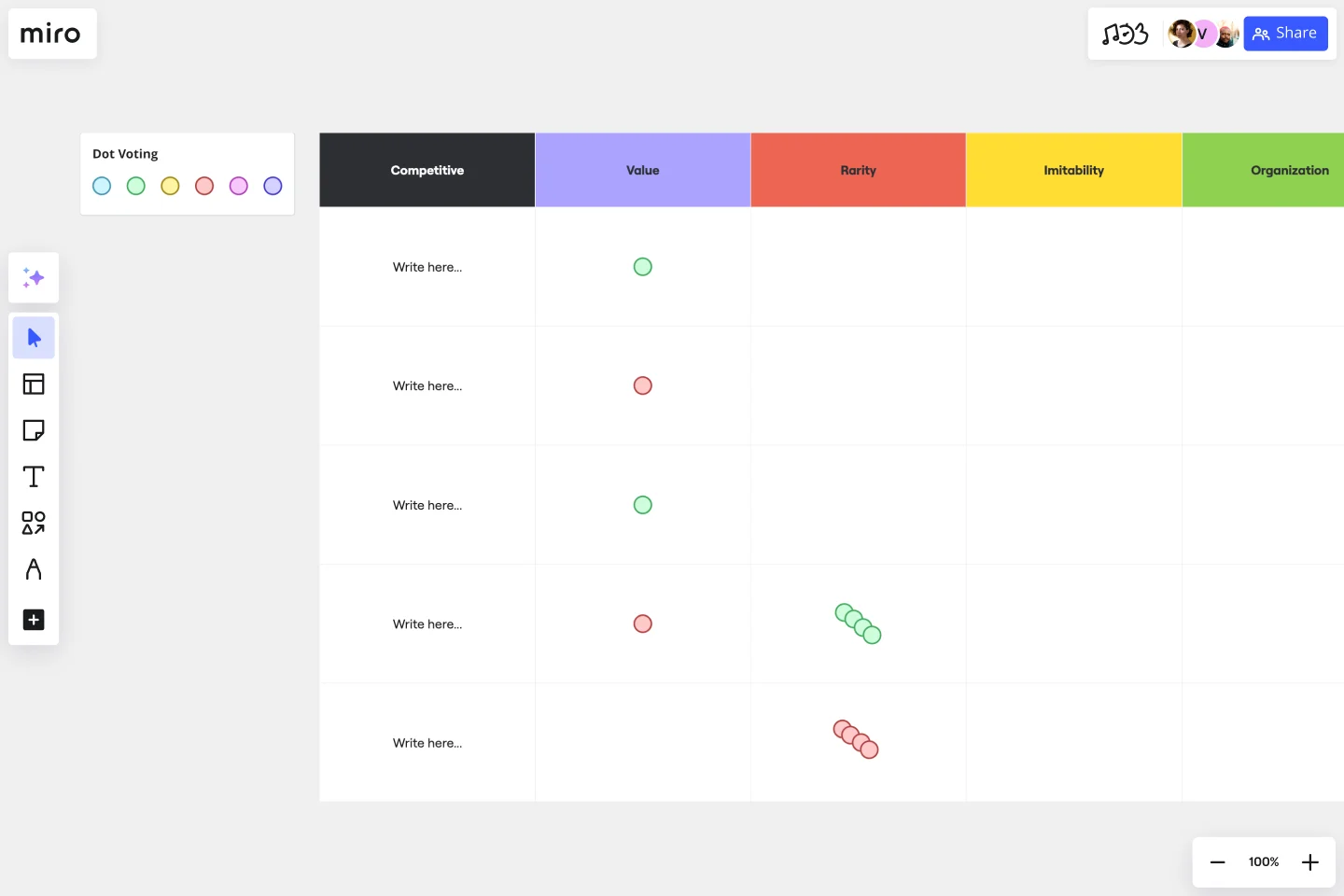
If you’re in the process of refining your strategy, the VRIO analysis template is a great tool. VRIO stands for Value, Rarity, Imitability, and Organization. This framework helps you evaluate your business’s internal resources and capabilities to see if they offer a competitive advantage.
Use this template when you’re trying to figure out what sets your business apart from the competition.
Strategy diamond template
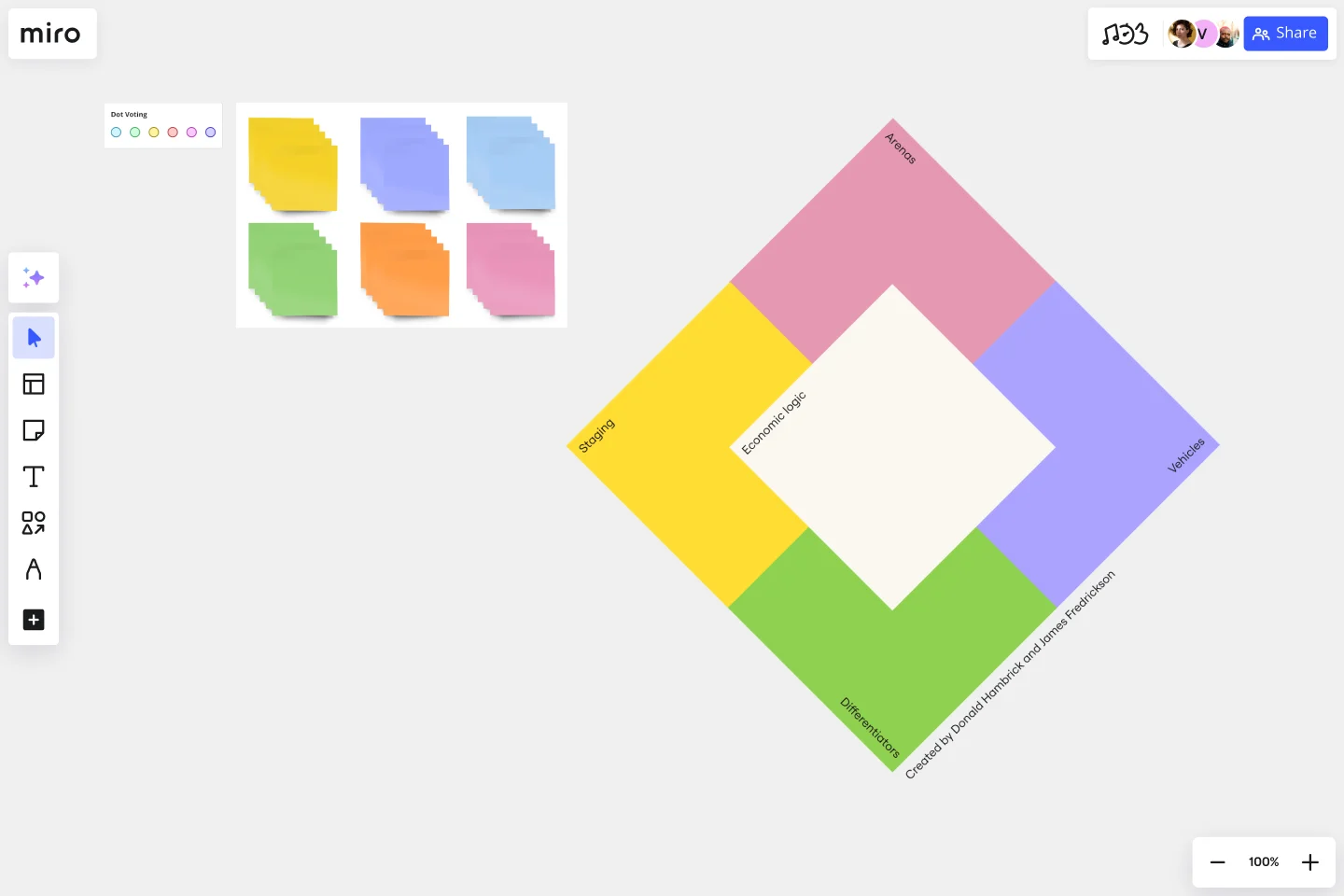
The strategy diamond is a framework that helps you look at five key elements of strategy: Arenas, Differentiators, Vehicles, Staging, and Economic Logic. This template encourages you to think about where you’ll compete, how you’ll win, and the tactics you’ll use to get there.
It’s a powerful tool for high-level strategic planning, helping you ensure your business plan is aligned with your long-term goals.
SOAR analysis template
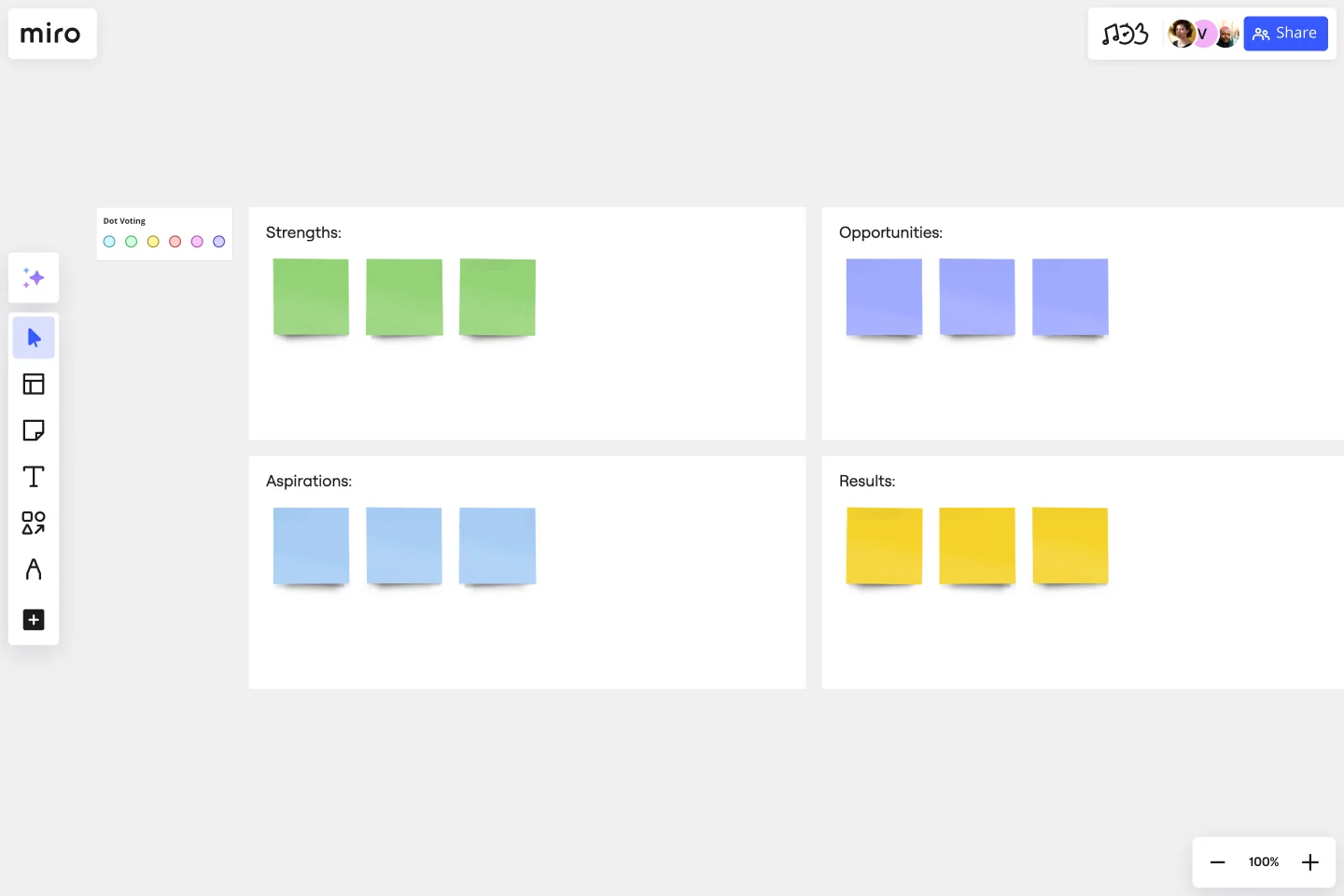
If SWOT analysis feels a bit too focused on the negatives, consider the SOAR analysis template. SOAR stands for Strengths, Opportunities, Aspirations, and Results. This framework focuses on the positives and helps you build on your strengths to create actionable plans for growth.
Use this template when you want to approach your business plan from a more optimistic, strengths-based perspective.
Strategize like a pro: Tips on how to make a business plan using Miro
When it comes to building a business plan, having the right tools and approach can make all the difference. Miro’s innovation workspace offers a flexible, collaborative environment that can help you move from brainstorming to execution. Here are some tips for getting the most out of it:
Start with the right template: Whether it’s a business plan, pitch, or mind map, begin with the template that best fits your needs to streamline your process.
Collaborate in real time: Use Miro’s real time collaboration features to bring your team into the process, whether you’re in the same room or across the globe.
Take advantage of asynchronous tools: Not all work has to happen at the same time. Miro’s asynchronous capabilities allow your team to contribute and leave feedback on their own schedule.
Visualize your ideas: Use sticky notes, diagrams, and charts to break down complex ideas and map out strategies visually.
Keep everything in one place:Miro integrates with other tools, so you can keep all your data, documents, and discussions in one organized space.
With these tips, you can create a business plan that not only looks good on paper but drives real results.
By using business plan templates and strategic frameworks, you can simplify the planning process and set your business up for success. Whether you’re working alone or collaborating with a team, tools like Miro’s innovation workspace can help you craft a plan that gets results—without getting bogged down in the details.
Author: Miro Team
Last update: October 22, 2025